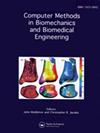Biomechanical effects of different loads and constraints on finite element modeling of the humerus.
IF 1.7
4区 医学
Q3 COMPUTER SCIENCE, INTERDISCIPLINARY APPLICATIONS
Computer Methods in Biomechanics and Biomedical Engineering
Pub Date : 2025-04-01
Epub Date: 2023-12-27
DOI:10.1080/10255842.2023.2298371
引用次数: 0
Abstract
Currently, there is no established finite element (FE) method to apply physiologically realistic loads and constraints to the humerus. This FE study showed that 2 'simple' methods involving direct head loads, no head constraints, and rigid elbow or mid-length constraints created excessive stresses and bending. However, 2 'intermediate' methods involving direct head loads, but flexible head and elbow constraints, produced lower stresses and bending. Also, 2 'complex' methods involving muscles to generate head loads, plus flexible head and elbow constraints, generated the lowest stresses and moderate bending. This has implications for FE modeling research on intact and implanted humeri.
不同载荷和约束对肱骨有限元建模的生物力学影响。
目前,还没有成熟的有限元(FE)方法对肱骨施加符合生理实际的载荷和约束。这项有限元研究表明,两种 "简单 "方法涉及直接头部载荷、无头部约束、刚性肘部或中长度约束,会产生过大的应力和弯曲。然而,2 种 "中间 "方法涉及直接头部载荷,但头部和肘部约束灵活,产生的应力和弯曲较小。另外,2 种 "复杂 "方法涉及肌肉产生头部载荷,加上灵活的头部和肘部约束,产生的应力最小,弯曲度适中。这对完整肱骨和植入肱骨的有限元建模研究具有重要意义。
本文章由计算机程序翻译,如有差异,请以英文原文为准。
求助全文
约1分钟内获得全文
求助全文
来源期刊
CiteScore
4.10
自引率
6.20%
发文量
179
审稿时长
4-8 weeks
期刊介绍:
The primary aims of Computer Methods in Biomechanics and Biomedical Engineering are to provide a means of communicating the advances being made in the areas of biomechanics and biomedical engineering and to stimulate interest in the continually emerging computer based technologies which are being applied in these multidisciplinary subjects. Computer Methods in Biomechanics and Biomedical Engineering will also provide a focus for the importance of integrating the disciplines of engineering with medical technology and clinical expertise. Such integration will have a major impact on health care in the future.

 求助内容:
求助内容: 应助结果提醒方式:
应助结果提醒方式:


